MUDS & CLAYS
WHAT IS CLAY ?
Clay is a naturally occurring disintegrated sedimentary rock that develops as a result of weathering and environmental erosion.
Since the appearance of man, various objects and utensils, including pots, glasses, plates, bricks, decorative items, sculpture, etc., have been formed from this fine grain when it is combined with water.
Ceramic is created when clay is fired, and potters may create a limitless variety of both functional and just ornamental things with this material.
WHAT ARE PRIMARY CLAYS ?
Primary clay is that which is found in its original location and has not been moved by wind or water.
It is a clay that is extremely rare and pure.
Due to their extreme hardness and lack of plasticity, potters hardly ever employ these clays.
Construction typically uses it in calcined form, which adds significant hardness.
Kaolin is the most popular type of primary clay.
KAOLIN CLAY
As kaolin is a primary clay that is both not very flexible and highly refractory.
This clay must be combined with other, more plastic clays and other elements to make it more manageable to enable it for lower firing temperatures.
Porcelain is mostly made from this primary clay, also known as residual clay.
DIFFERENT TYPES OF CLAYS

The potter, sculptor, or ceramist will select the one that best suits them to create the ceramic piece they plan. They are particularly concerned with the clay’s flexibility, as well as its texture, color, and the temperature at which it should be fired as well as the degree of hardness it can get.
WHAT ARE SECONDARY CLAYS ?
Secondary clays are those that have been dispersed and eroded by wind, water, and other weather-related elements, before deposited in different sedimentary layers. These clays melt at lower temperatures, have a higher iron and oxide content than the preceding ones, and are more plastic. It is frequently referred to as ball clay.
STONEWARE
Stoneware is created by combining natural secondary clays with vitrifying clays, which give it its primary properties of impermeability and opacity.
Often used for high-temperature glazes, stoneware has excellent plasticity.
REFRACTORY CLAY
Fireclay is a secondary clay with a high impurity level. Typically, it is used mostly to make bricks, clay pots, etc. It is a clay that can withstand extremely high temperatures.
After it has been fired and grounded to the desired grain, it is also used to make chamotte.
EARTHENWARE CLAYS
It is the most popular of all, and most potters use it to model their ceramic pieces.
Its characteristic reddish terracotta color comes from its high iron oxide content. It is also incredibly fine and simple to handle on the ceramic wheel.
BENTONITE CLAY
Bentonite is a volcanic ash-based clay.
Because to its high plasticity, this clay is often blended with other clays to make it easier to work with.

 ...
...